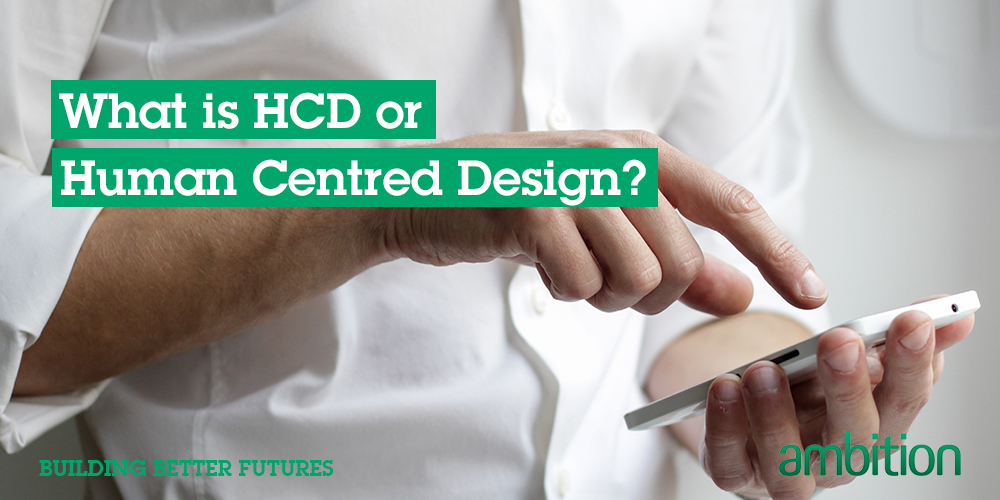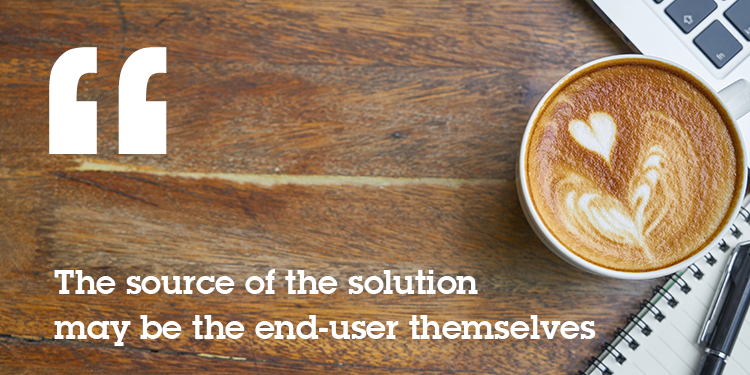Please beware of recruitment scams that are currently targeting jobseekers. Click here for further advice.

What is HCD or Human Centred Design?
Recently I’ve had several conversations with candidates and clients regarding Human Centred Design (HCD). What is it? It seems to be a buzzword lately, but how valuable actually is it? Is it just a framework applicable to UX Designers, or should Project Managers and Change Managers use HCD? What does the talent market look like?
What is HCD or Human Centred Design?
Recently several of my colleagues purchased Apple AirPods. I’ve observed that when we are walking together, they quickly notice others with AirPods. You may have had the same experience when you have purchased a new car and notice others with the same car. This is known as the Reticular Activation System, which changes your observations based on what your brain determines is important to you. By changing the way we approach a problem, we can use this to our advantage to solve a problem more effectively. HCD is a design framework that puts the needs of the people you are designing a solution for at the forefront. It isn’t necessarily about the appearance of a product or solution, but how the problem is approached and the process of identifying a solution.
Human Centred Design consists of three phases;
Inspiration
Ideation
Implementation

The Inspiration phase is interacting with the end-user which may be customers or impacted employees. Fully understanding their needs and motivations for a solution or improvement. This is followed by the Ideation phase which consists of developing possible solutions to the problems identified. These possible solutions are checked with the end-users for feedback and recalibration if required. Lastly, Implementation is making the final solution and implementing or making available for end-users. I’m sure you’ve heard the saying, “Happiness is a journey, not a destination.” HCD is much the same, it doesn’t stop once a solution has been implemented. It analyses and tests the solution to see if there are potential improvements or changes that can meet the needs and desires of the end-user. The logic of the process is because you have used the needs of the customer to create the solution, you know it will solve the pain points identified. You never know, the source of the solution may be the end-user themselves.
While it isn’t a formal stage of HCD, empathy is also critical to the success of using HCD. Being able to ask the right questions and action the findings accordingly. This requires soft skills to be able to elicit meaning and understanding regarding the emotional and physical needs of end-users. Without being able (and willing!) to listen and understand the needs and desires of the end-user, the product or solution won’t be focused on them, but the needs and desires of the designer.
“When you understand the people you’re trying to reach—and then design from their perspective—not only will you arrive at unexpected answers, but you’ll come up with ideas that they’ll embrace.”
– IDEO, Field Guide to Human Centered Design
What are the challenges of Human Centred Design?
HCD certainly isn’t without its potential downsides. We once used to believe we were at the centre of the universe, we have grown and developed to understand that we are part of a much bigger picture. Narrowing our focus on a end-user's issue may allow us to find the perfect solution for the individual, but this may be at the expense of others. Holding the human perspective at the core of our solutions has enabled us to make great user improvements, but it is incredibly hard to scale when you are always looking to resolve a single component. There are several moving parts, and just like a clock, they all need to work together to be productive. Looking to solve problems on an individual basis prevents us from seeing the larger picture, and for more technical problems may even make it harder to find a solution.
How are organisations already using Human Centred Design?
For organisations operating in an increasingly competitive environment, being able to make solutions that are the best fit possible to the target market is a great way to secure competitive advantage. The Industrial Revolution and “one size fits all” solutions are a thing of the past, solutions need to be tailor-made for customers to be able to stand a chance. Organisations who have significant success stories with HCD include Samsung, Microsoft, Kellogg, Netflix, Pinterest and Airbnb. Just a few small players, I’m sure you haven’t heard of them. Interestingly enough, many of these projects were successfully delivered using partnerships with other organisations who had more experience using HCD.
Netflix is a master of using HCD. Blockbuster didn’t stand a chance when customers were faced with a service that met their needs and desires so effortlessly, and it wasn’t just a one-off innovation. There was a movement in making entertainment more convenient and accessible for the end-user. Initially, even having movies delivered to your door in comparison to having to drive to a store made the process easy for customers. Netflix took it a step further. Now, you don’t have to go to the front door or wait a few days for your movie of choice. Streaming options means that your favourite TV shows are available on the device of your choice, in your location of choice. Meanwhile, Blockbuster failed to innovate and adapt to their customer’s desires and is long gone.
One example where designers didn’t put the needs and desires of the end-user was the Google Glass. In 2013, it sounded like the next big thing. A pair of glasses by Google that could send messages, display information and take photos. I can’t say I personally remember ever seeing someone wearing a pair. The problem was, during design the social implications of voice activation and control weren’t considered. As a result, the product uptake failed, big time. This example particularly identified that understanding and empathising with the end-user is critical. Just because a product was cutting edge technology and has some great bells and whistles, it might not hit the mark of what end-users are looking for. MIT Technology Review summed up their opinion on the Google Glass:
 | “No one could understand why you’d want to have that thing on your face, in the way of normal social interaction.” From MIT Technology Review |
Human Centered Design and Change Management
By considering the end-users from the beginning of the change process, adoption can be managed from the beginning. This can be implemented into change plans and affect conversations with those impacted by the change. Understanding what the end-user wants for adoption of change before the solution is developed makes adoption almost certain if the needs of the end-user are kept front of mind during the Ideation and Implementation phase. It also establishes the mindset of a need for change for the end-user.
How much easier is it to adopt change that impacts you, if your needs, skills, and motivations were considered from the get-go? If these human factors for adoption are established at the beginning, they can also be used as metrics of success. If HCD is used for change management, employees who are affected are far more likely to have a positive experience as their views, experiences and ideas were considered throughout the change process. This can lead to the employees themselves becoming supporters and advocates of change as well.
“Instead of seeing it’s primary objective as consumption, design thinking is beginning to explore the potential of participation. The shift from a passive relationship between consumer and producer to the active engagement of everyone in experiences that are meaningful, productive and profitable.”
Human Centred Design and Project Management
For a project team, sometimes it is difficult to identify the value add and the big picture of the project. Using HCD provides clarity on the actual problem or opportunity that the project is aiming to provide a solution for. It isn’t an approach that should lead to “doing things how we have always done things” but rather innovative solutions. It can be used for both technical and non-technical projects where the end-user is able to identify potential solutions. You can also suggest ideas to end-users and get feedback or suggestions on whether the idea/feature would be useful or if there’s a better way of doing it. For this to be successful, it needs to be driven from the top of the organisation.
Wrapping up, I think HCD is a very valuable addition to the toolbox of a Change Manager or Project Manager. It reduces risk and it isn’t a gamble of whether it will solve the route of the problem. I think this is especially important when the end-user is impacted employees who have a close relationship with those who are implementing the solution. While it appears to be a relatively common skillset within the public sector, it seems underutilised and under prioritised within most private organisations. While this is my opinion, I’m expecting the adoption of HCD to increase, particularly within the private sector.
We love to hear your thoughts, is Human Centred Design a framework you do use, or want to use? Click here to contact the team.


%20(1)%20(1).jpg)

.png)


